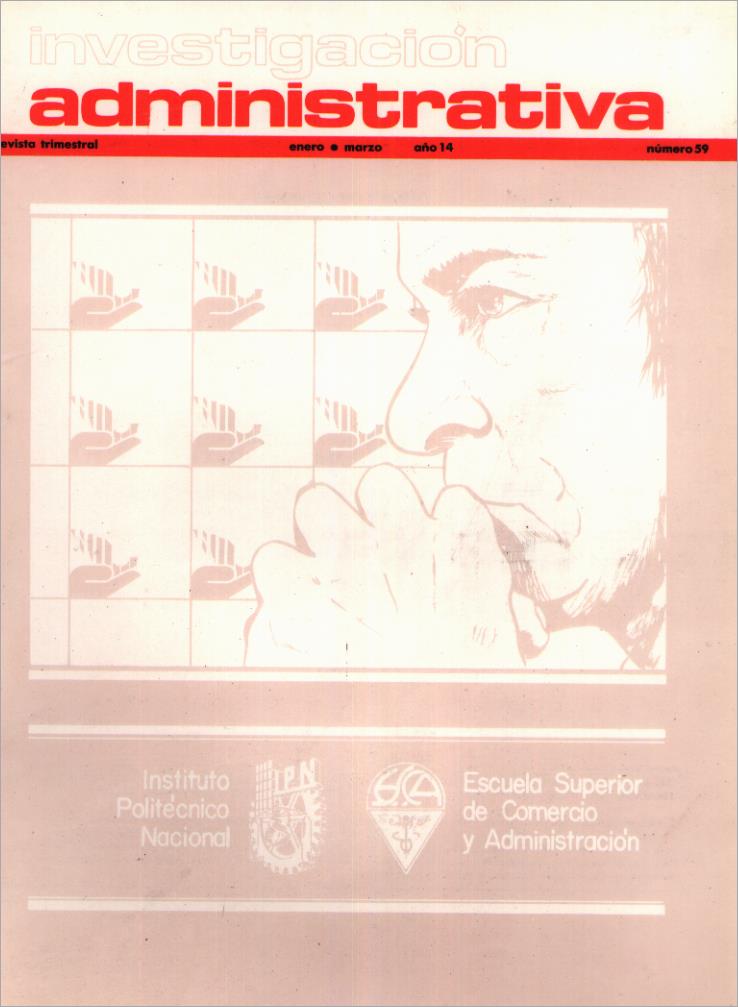Estilos de gestión organizacional, estatus de supervisión de empleados y respuestas de los empleados
Contenido principal del artículo
Resumen
Detalles del artículo

Esta obra está bajo una licencia internacional Creative Commons Atribución-NoComercial 4.0.
Citas
Argvris, C. Interventíon theorv and method,
Reading, Massachusetts: Addison-Wesley, 1970.
Astley, W. G., 8c Van de Ven, A. H. Central pers pectivas and debates in organization theory. Ad ministrativo Science Quarterly, 1983,28,245-273.
Bass, B. M. Stogdill’s handbook ofieadership(Revi- sed Ed.). New York: The Fice Press, 1981.
Beehr, T. A., & Newman, J. E. Job stress, employee health, and organizational effectiveness: A facet analysis, model, and líterature review. Per son n el Psychology, 1978, 31, 665-699.
Berger, C. J., & Cunnnings, L. L. Organizational structure, att iludes, and behaviors. In B. M. Staw (Ed.), Resea rch in organiza liona! beba vior (Vol.
. Greenwich, Connecticut: JAI Press, 1979.
Bourgeois, L. J., III. Strategic management and determinista. Academy of Management Review, 1984,9,586-596.
Brief, A. P., Schuler, R. S., & Van Sell, M. Managing job stress. Boston: Little, Brown, 1981.
Drexler,J. A.,Jr. Organizational dimate: Its homo- ge ncity within organizations. Journal of Applied Psychology, 1977, 62, 38-42.
Gupta, N., & Beehr, T. A. Job stress and employee behaviors. Organizational Behaviorand Human Performance, 1979, 23, 373-387.
Hackman, J. R., 8c Oldham, G. R. Work redesign. Reading Massachusetts: Addison-Wesley, 1981.
Ingham, G. Size of industrial organizaron and wor- ker behavior. Cambridge, U. K.: Cambridge Uni- versity Press, 1970.
Ivancevich, J. M.» & Matteson, M, T. Stress and work: a managerial perspective. Glenview. Illí- noís: Scott, Foresman, Se Co., 1980.
Jenkins, G. D., Jr., & Gupta, N. The payoffs of
paying for knowledge. Nacional Productivitv Review, 1985, 4(2), 121-130.
Jenkins, G. D., Jr., Nadler, D. A., Lawler, E. E., 111, Se Caminann, C. Standardized observations: An approach to measuring nature ofjobs. Journal of Applied Psychology, 1975,60, 171-181.
Joyce, W. F., 8c Slocum J. W, Colicoli ve dimate: Agreement as a basis for defining aggregate di mates in organizations. Academy of Management JournaL 1984, 27, 721-742.
Kahn, R. E., Wolfe, I). M., Quinn, R. P., Snoek, J. D., 8c Rosenthal, R. A. Organizational stress: Studies in roleconflict andambiguity, New York: Wiley, 1964.
Kimberly, J. R. Organizational size and structura- list perspective; A review, critique, and proposaL Administrad ve Science Quarterly, 1976, 21, 571-597.
Lawler, E, E.. III. The new plant revolution. Or ganizational Dynamics, 1978, 6(3), 2-12.
Lawrence, P. R., 8c Lorsch, J. Organization anden- vironment: Managing differenliation and ínte gra tion. Homevvood, Illinois: Irwin, 1969.
Likert, R. New parteros of management. New York: McGraw-Hill, 1961.
Likert, R. Tbe human organization. New York: McGraw-Hill, 1967.
Newman, J. E. Understanding the organization structure-job attitude relationsbip through per- ceptions of the work environment. Journal of Applied Psychology, 1975, 14, 371-397.
Oldham, G. R., & Hackman, J. R. Relationsbip betwcen organizational structure and employee reactions: Comparing alternad ve framework. Administrative Science Quarterly, 1981. 26, 66-83.
Parchen, M. Some questionnaire measures oí empioyee motivation and inórale. Monograph
No. 41, Institute for Social Research, Ann Arboi Michigan, 1965.
Pe n ley, L. E., & Hawkins, B. Studying ínter perso nal communicadon in organizarons: A leader- ship association. Academy of Management Jour- nal, 1985, 28, 309-326.
Poner, L. W., & Lawler, E. E., III. Properdes of organizadonal structure in relation tojob alti tudes and job behavior. Psvchological Bulletin, 1965, 64, 23-51.
Quinn, R. P., & Shepard, L. J. The 1972-73 quality of employrnent survey. Ann Arbol, Michigan: Survey Research Center, 1974.
Rosscau. D. M. Technological differences in job characteristics, empioyee sadsfaedon and motiva- don: A synthesis ofjobdesign research and socio- technical systems theory. Organizadonal Beha vior and Human Performance. 1977, 19, 18-42.
Scott, W. G., Mítchell, T. R., & Ferry, N. S. Organí- zational governance. In P. C. Nystrom & W. H. Starbuck (Eds.). Handbook of organizadon de sign (Vol. 2). New York: Oxford UniversiLy Press, 1981, pp. 135-151.
Starbuck, W. II. Organizations and their envi- ronmcnU. In M. D. Dunnette (Ed.). Handbook of industrial and organizadonal psychoJogy, Xcw York: Wiley, 1983, pp. 1069-1123.
Steers, R. M., & Rhodes, S. R. Major influentes on empioyee attendance: A process model. Jour- nal of Applied Psychology, 1978, 63. 391-407.
Survey Research Center. Efíectivcness in work ro les: Empioyee responses lo work environments. Springfield, Virginia: National Technique In forma non Service, 1977.
Talacchi. S. Organizadonal size, individual altitudes and behavior: An empirical study. Adniinistrati- ve Science Quarterly, 1960, 44, 216-223.
Tannenbaum, A. S. Hierarchy in organizations.
San Francisco: Jossey-ttass, 1974.
Wakon, R. & Schlesinger, L. A. Do supervisor» ihrive in parücipadve work systems? Organiz.a- tional Dynamics, 1979, 7(3), 24-38.

